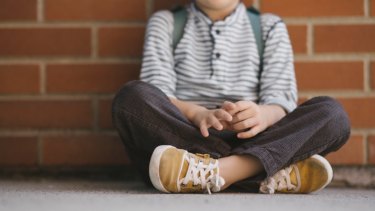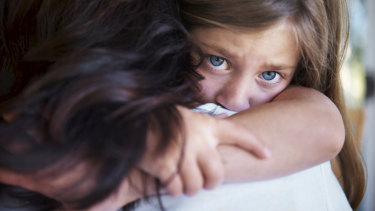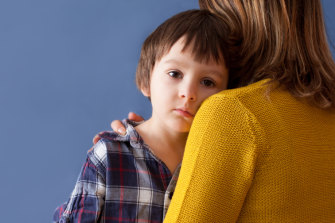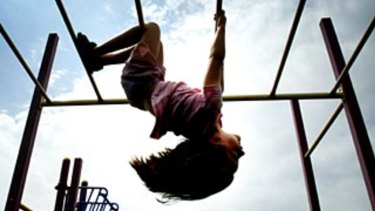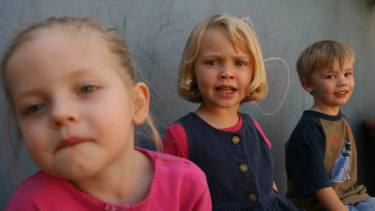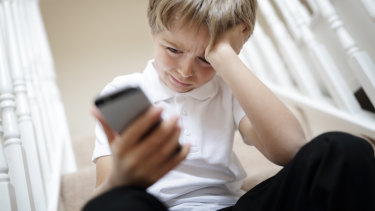Are children experiencing more anxiety or have we become better at noticing?Credit:Stocksy
They refer to it as a “low hum”.
It’s not at the front of their minds as they go about their day, it’s not something constantly tugging at them as they rush from work to school pick-up to after-school activities to monitoring homework, to overseeing bedtime and then baking a cake for tomorrow’s fundraiser.
But for many parents of primary school students, their child’s anxiety is the constant static in the background, occasionally becoming louder when their child responds unexpectedly to a social event, bursts into tears without warning or refuses to go on school camp.
For Alyssa*, the “low hum” from her seven-year-old daughter, Jamie, started when the normally happy little girl started to worry that she didn’t have a best friend and “everyone else seemed to have one except her”.
After prising as much information out of Jamie as she could, Alyssa decided the anxiety was part of the usual vagaries of childhood and Jamie would get through it. But it didn’t stop – and then it got worse. Jamie starting worrying about a lot of seemingly minor things, a lot of the time. And there were physical manifestations too: she would be short of breath, stressed, lashing out at her younger sister, overwhelmed by minor challenges.
“Sometimes it looks to my inexpert eye that she’s having a panic attack,” Alyssa says.
When Jamie’s teacher called Alyssa in to talk about Jamie’s resilience in class and suggested the girl see the school counsellor, “that was a bit of a wake-up call for me”. It’s not that Alyssa hadn’t expected some anxiety in her children, it’s just that she hadn’t expected it to rear its head so early in her daughter’s life.
While much attention has been paid to anxiety in adolescence, far less has been paid to primary school-aged children.Credit:iStock
It’s a story that is told over and over again by principals, doctors, psychologists and parents: anxiety in primary school children seems to be on the rise. But the question is whether there is a real rise in anxiety or simply greater awareness of it and more willingness to seek help for it. And if there is real rise – as many professionals spoken to for this article believe – then what on earth is going on?
There is very little research to help answer this question. While much attention has been paid to anxiety and depression in adolescence, far less has been paid to primary school-aged children. It was long assumed that those years between the relentlessness of toddlerhood and the onset of puberty were a quiet period where not much happened.
But that view is slowly being overturned, with growing awareness that anxiety and depression in young children needs to be identified and treated, not only for childhood health, but for the sometimes turbulent pubescent years.
The best data on the prevalence of anxiety in four to 11-year-olds comes from the federal government’s 2015 survey of the mental health of children and adolescents. It found that anxiety disorders are as prevalent in primary school children as they are in adolescents, affecting 6.9 per cent of children, with almost no difference between genders.
Longitudinal or trend data is harder to come by, but recent research by the Murdoch Children’s Research Institute found that anxiety diagnoses in children and adolescents made by pediatricians nearly doubled in the five years from 2008 to 2015. One of the study’s authors, Associate Professor Emma Sciberras, believes there is likely to be both a real rise in anxiety levels and greater awareness and willingness to seek help for it.
The reasons for this increase in worried children are complex. First of all, it’s completely normal for people – including young children – to feel anxiety some of the time. We lead fast-paced lives, we constantly use technology that is equal parts connecting and invigorating, on the one hand, and enervating and corrosive on the other. And we are, of course, complex creatures with complex relationships – even the very young among us.
But what is not normal, where children are concerned, is when the hum turns into a beating drum; when it stops them from doing what they ought to do or what they want to do.
It is impossible to look past the way we parent as a starting point for children’s state of mind.Credit:iStock
It’s impossible to look past the way we parent as a starting point. This is not to blame parents as such – most of us are doing the best we can, most of the time – but to examine the changes to parenting itself and the pressures on mums and dads that inevitably trickle down to children. We work hard, we are “time-poor” in the modern parlance, we are constantly pulled in many different directions. Competition is everywhere and it is fierce, and parenting has never been as forensically examined – and criticised – as it is now.
There’s a genetic element to all this, too: anxiety, like curly hair, runs in the family. It is widely accepted that if you are an anxious parent, you are more likely to have an anxious child.
And “the thing we know about anxiety is that it’s catchy”, Sciberras says. “If you’re around a person who is anxious, you can easily become anxious yourself”.
Ian Hickie, a professor of psychiatry at Sydney University, says it is very hard to know if the rise in anxiety is real given the paucity of scientific evidence, but there is no doubt there is greater awareness of it. And while some parents may worry about pathologising normal human behaviour, Hickie believes the risk of that is actually very low. In the past, when anxiety problems carried far greater stigma than they do today, “many kids with anxiety were ignored and ended up housebound and not achieving their potential”.
One of the constant talking points these days is over-protective parenting, the much-maligned “helicopter” mum or dad.
Play, which is actually hugely important for children’s development, is often crowded out by activities.Credit:Ben Rushton
Calls to discuss issues causing children anxiety or depression certainly keep the counsellors at Kids Helpline busy. Manager Tony Fitzgerald says that over the past six months, the service has received about 500 calls from children aged five to 12 to discuss anxiety or depression. And while it’s hard to compare those figures meaningfully over time, “anecdotally the team that are working in that program are hearing a lot more from teachers needing support around not just anxiety but general mental health, including discussions around self-harm”.
Professor Frank Oberklaid of the Royal Children’s Hospital’s Centre for Community Child Health is in no doubt that anxiety among younger children is on the rise. The anecdotal evidence is that there has been a huge increase in anxiety in the past decade and that it has become more overt and harder to deal with.
“For teachers and principals having to deal with this in their day-to-day work, it’s the elephant in the room,” he says. And there is no doubt that the wider cultural environment in which children are being raised is having an impact on their emotional health, something he refers to as “social climate change”.
Parents are very anxious about their parenting, about whether they are doing enough for their child. One of the side-effects of this is the over-scheduled child. Some children have their weeks filled up with activity after activity, along with homework or tutoring, so that every minute of their day is accounted for – and under pressure. They are not allowed to be bored or to play, which is actually hugely important for children’s development.
In an increasingly competitive environment, children are expected to succeed academically, learn an instrument, play sport and be happy.Credit:Steven Siewert
This all fits in with what feels like an increasingly competitive environment for children, where they are expected to succeed academically, learn an instrument, play sport and be happy. Principal of Glendal Primary School in Glen Waverley, Deborah Grossek, sees over-scheduled children all the time. Parents are highly ambitious for their children, and children become anxious if they are not getting A's. They also worry about their social groups.
“It seems children have less time, and downtime to play is not seen as valuable,” Grossek says. “It’s natural for parents to want their children to succeed; I think the problem is when they’re not allowed to fail.”
Instead, she talks to her students about “bouncing forward” – the ability to be resilient, to dust yourself off and keep going. Because considered risk-taking is actually good for children and “we have children who won’t do things because they can’t do them perfectly”.
Mentone Grammar principal Mal Cater also worried about children having little time to enjoy being children. He doesn’t like to say that anxiety is on the rise, because he sees it as a self-fulfilling prophecy: “The more we actually promote that it is on the rise, the more it will actually be on the rise."
But “children’s lives seem to be organised within a minute of existence”, he says, and there is little time for them to make their own fun. Instead, he advises parents to “just let the children be children for as long as we possibly can”.
Malcolm Elliott, president of the Australian Primary Principals Association, is in little doubt that anxiety is on the rise in primary schools – both diagnosed and undiagnosed. He worries about the pressures on kids with assessments like NAPLAN, which encourage competition and comparison. From decades of experience as an educator he is also in no doubt that parental anxiety is rising, too. “The desire for the best for their children turns into the expectation that their children will achieve at the very highest level,” he says.
Then there is the issue of screens, something we seem endlessly to fret about and then, just as endlessly, do little to change. It’s not simply about the amount of time children spend in front of screens, but exactly what they are watching. Often it is TV shows, YouTube clips or other entertainment that is simply too adult for them.
Elliott says children often seem to be free to watch whatever they want. “Too many parents are abrogating their responsibilities to actually parent their child, because it’s easier to give in.”
Children’s access to screens – and the material they see on them – is much discussed but often less acted upon.Credit:iStock
It’s not just access to violent or pornographic material, but the images of success with which children are bombarded online: the ripped bodies, the curated lives, the unreal and very narrow images of beauty. Teachers, he says, see a lot of the anxiety from this reflected in students’ writing at school.
So what to do? Frank Oberklaid likes to talk about “scaffolding” – building a strong emotional framework for good mental health. Turn the screens off and talk. Limit screen time. Know what your kids are watching and the social media they are using. “Kids need limits, kids need structures, and when you don’t provide those, kids get very anxious,” he says.
Sleep is also an underestimated contributor to children’s anxiety. Emma Sciberras was a researcher in a large 2018 study of 4000 Australian children, which found evidence that lack of sleep can lead to emotional problems but not – perhaps contrary to popular belief – that emotional problems lead to poor sleep. In other words, fix the sleep and the anxiety may well abate.
So one strategy, Sciberras says, might be for parents to review how many after-school activities their children have – could one be cut? – and insisting on some screen-free time before bed to wind down and prepare for sleep. Also, try to resist the pressure to be that impossible thing, a “perfect” parent, and instead allow yourself to make some mistakes. “Most parents are doing a really good job and, for the most part, if you’re doing a reasonable job that’s going to be fine.”
Of course, the world around us can be enough to cause any of us anxiety. Children are no different, says Marilyn Smith, principal of Preshil school, and they worry about climate change or social issues such as violence or homelessness.
She feels this is something that has increased markedly over her career in teaching, and so the school concentrates on student “agency” and the idea that young people can act on issues or their environment. That way they don’t feel so powerless and scared.
“I think sometimes children feel that maybe the adults aren’t in charge,” she says, “and that’s really frightening”.
*Names of parent and child have been changed.
Children of all ages who need to talk to someone in confidence can contact Kids Helpline on 1800 55 1800.
Source: Read Full Article







